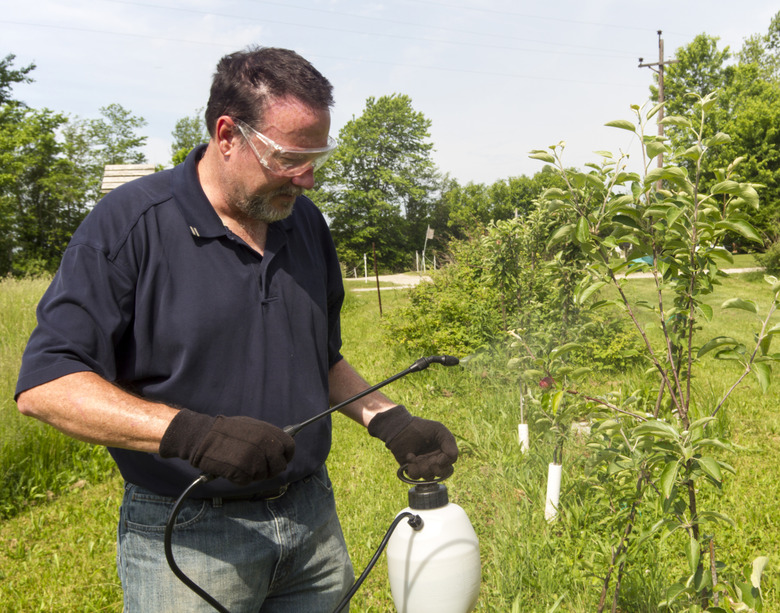When & What Do I Spray On Plum Trees?
Plum trees (Prunus domestic and Prunus salicina) thrive in U.S. Department of Agriculture hardiness zones 4 through 9 and can provide you with plenty of delicious fruit, but only if you make sure that you control the pests and diseases that can destroy your crop. Plum trees are susceptible to a number of problems. The proper application of sprays at the right time helps to ensure that your trees give you fruit and not grief.
When to Spray
Rather than checking off the same dates on a calendar each year, it's best to time your spraying sessions to the stages of the plum tree fruiting cycle each season.
Tip
Each part of the country tends to have a different balance of pests and diseases, so it's helpful to ask at a local nursery or county extension what affects plum trees where you live and use spray that targets those problems.
Before Buds Appear
Spray your plum trees with dormant oil with endosufan or malathion to control mites, scale insects, peach tree borer and aphids. If plum pockets and leaf curl are a problem in your area, the spray should include captan fungicide.
Warning
Dormant oil must be applied when a freeze is not expected; if the temperature dips below freezing, the oil can cause serious damage to your trees.
When Buds Show Color
When the buds on your plum tree being to show color but have not opened yet, it's time to spray again. Keep the Oriental fruit moth and the twig borer under control by applying Bacillius thuriengensis to the trees. Also apply captan to control plum pockets, brown rot, leaf curl and scab.
After Petal Fall
Once the petals have fallen from your plum trees, check for the presence of aphids. If they are a problem, add some dishwashing liquid to malathion to help the spray stick to the leaves and apply, being sure to get inside any curled leaves. Spray again with Bt to control both Oriental fruit moths and twig borers. Apply captan again for plum pockets, brown rot, leaf curl and scab.
Throughout the Season
Wait until the fruit has begun to develop and the husks are beginning to pull back from the fruit, and then spray plum trees with spinosad, esfenvalerate or permethrin to control twig borers. A mix of captan, malathion and sulfur can be used to leaf curl, plum pocket, scab and brown rot, as well as insect pests such as aphids and the peach tree borer. Spray every 10 days as the fruit develops; stop spraying about a week before harvest.
Spraying Equipment
Spray smaller plum trees with a handheld pump-activated sprayer, available in many home centers and nurseries. If you have a lot of trees to spray or if your trees are too tall for the spray from the handheld pump to reach every surface, use a motorized sprayer.
How to Spray
Warning
Plum tree sprays can be toxic, so always protect yourself when applying sprays. Use protective clothing. Always shower after spraying to remove any chemicals on your skin. Wash your protective clothing separately from other clothing. Never spray on windy days to minimize the risk of the spray ending up where it isn't wanted. Store all chemicals in their original containers, and keep them where children and pets can't reach them. Read and follow the original label directions.
Things Needed
-
Protective clothing: hat, rubber boots, long pants, rubber gloves, long sleeves, face shield or goggles
-
Sprayer
-
Appropriate spray
Step 1
Put on protective clothing before you begin working with plum tree spray. This includes hat, rubber boots, long pants, rubber gloves, long sleeves and a face shield or goggles.
Step 2
Fill a handheld or motorized pressure sprayer with the appropriate spray for the current stage of your plum tree's fruiting cycle, such as before bud break or after the petals have fallen. Pressurize the sprayer.
Step 3
Work systematically to spray all parts of the plum tree. Spray enough to saturate the entire plum tree, including the trunk and the upper and center branches.
Step 4
Use plenty of water to rinse the nozzles, hoses and tank thoroughly after spraying, making sure no residue is left behind. Place the tank and other components in a way that lets the water drain out, allowing the equipment to dry.
Warning
Many sprays are corrosive and can damage your spraying equipment in a short time if the equipment is not well cleaned. Old sprays can also interact with new sprays placed in the sprayer, causing a reaction that can cause damage to your plum trees. Never leave spray in the sprayer tank, even if you're going to be using the same spray again, because the spray will break down in the sprayer, rendering it ineffective when applied to trees.
